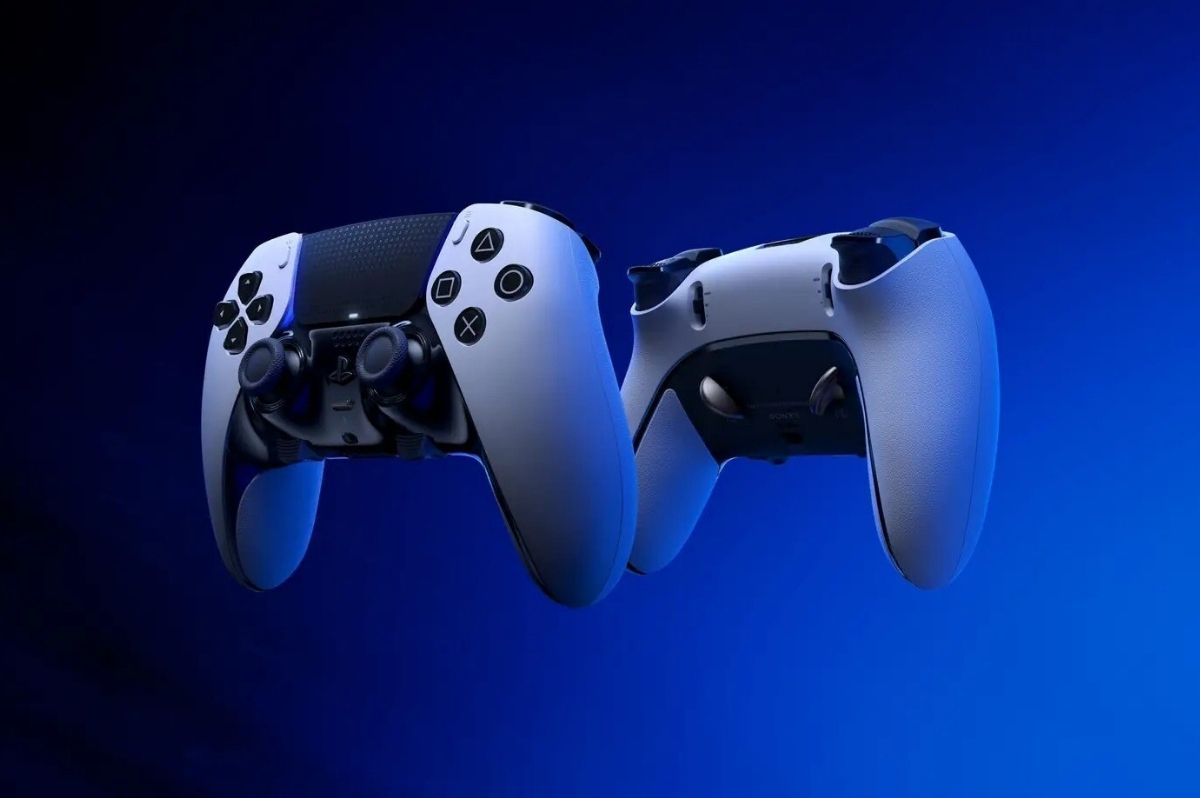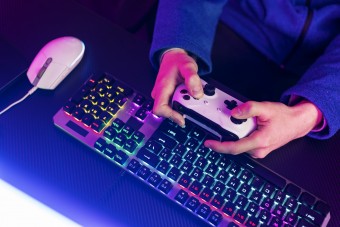Як вибрати ігровий геймпад
Ми незалежно перевіряємо товари та технології, які рекомендуємо.

1. Геймпад vs. джойстик: у чому різниця?

Геймпад і джойстик — це принципово різні пристрої для керування, хоча їх часто плутають.
- Геймпад — універсальний контролер з двома стіками, боковими тригерами/бамперами, хрестовиною та керуючими кнопками (A, B, X, Y або символи). Це класичний варіант керування, який використовується на ПК та консолях для шутерів, екшенів, платформерів, файтингів та багатьох інших жанрів.
- Джойстик — пристрій з довгою рукояткою, додатковими кнопками та опціональним дросельним важелем. Джойстики зазвичай створені для космічних та авіа-симуляторів на кшталт Microsoft Flight Simulator.
2. Сумісність з платформами

Раніше питання сумісності грало куди більшу роль, особливо в епоху консольних війн. Зараз же, коли ексклюзиви стають рідкістю, виробники прагнуть до універсальності. Наприклад, Sony DualSense, на відміну від DualShock 4, без проблем підключається до ПК. Проте повної кросплатформеної сумісності досі немає: геймпади від Xbox не працюють з PlayStation, а DualSense — з Xbox.
- Якщо ви шукаєте універсальний варіант для ПК та смартфона, краще дивитися на моделі з Bluetooth та офіційною підтримкою XInput. Це може бути фірмовий геймпад від Xbox, а також альтернативні варіанти від 8BitDo або GameSir.
- Для консолей зазвичай надійніше брати офіційний контролер, оскільки не всі сторонні геймпади підтримують фішки на кшталт адаптивних тригерів. Тим більше, що Sony та Microsoft пропонують і Pro-версії — DualSense Edge і Xbox Elite.
- У разі геймпада для смартфона, переконайтеся, що він підтримує необхідну платформу (Android або iOS), а також передбачено чи кріплення для смартфона (про це далі).
3. Оптимальне розташування елементів керування

Якщо відкрити топ продаж геймпадів, то ви побачите, що більш ніж 90% популярних моделей так чи інакше імітують 2 типи розкладки ― PlayStation та Xbox. У PS-подібних геймпадів обоє стіків розташовані симетрично, а 4 основні кнопки позначені геометричними символами, тоді як у Xbox лівий стік і хрестовина розташовані асиметрично, а основні кнопки позначені літерами ABXY. Який з варіантів кращий і зручніший залежить виключно від звички, індивідуальних уподобань та улюблених жанрів.
Асиметрія Xbox часто зручніша для шутерів і екшенів, де стіки — ваші головні інструменти, а симетрія PS виграє у файтингах або платформерах завдяки доступній хрестовині. Розмір рук також грає роль: PS-розкладка дружня до невеликих долонь, а масивні Xbox-контролери краще лягають у великі руки. Новачкам варто потримати обидва варіанти у справі — хвилин 10 у грі покажуть, що ближче.
Ну а якщо хочеться максимальної гнучкості, зверніть увагу на геймади з кастомними кнопками та стіками на кшталт ThrustMaster eSwap — налаштуйте розкладку під себе.
4. Тип підключення

Як і у випадку з розкладкою, відповідь на питання «з проводом чи без» багато в чому залежить від особистих уподобань і звичок.
Дротовий геймпад гарантує стабільне з'єднання, практично не має затримки вводу і не вимагає підзарядки. Він зручніше, якщо ПК або консоль підключено до монітора, а гравець сидить прямо навпроти нього.
Бездротовий забезпечує свободу рухів і повністю вирішує проблему з плутаниною проводів. Такий варіант особливо хороший, якщо ви хочете пограти на великому телевізорі, лежачи на дивані.
Загалом, бездротові моделі практичніші, тим більше що при розрядці їх можна підключити за допомогою кабелю і продовжити грати. Вони коштують дорожче, однак вибір не обмежений одними лише брендами-важковаговиками, у продажу вистачає цілком якісних і більш доступних варіантів від GameSir, Trust та A4Tech.
5. Якість стіків

Форма і матеріали також грають важливу роль. Наприклад, у колись популярному Logitech F310 стіки виконані у формі невеликих горбиків і поклавши руку на серце, це не найзручніший варіант так як замість надійної фіксації пальці могли ковзати вбік. Зворотний приклад - зручний DualShock 4 з невеликими виїмками під великі пальці. Грати в умовну FIFA або PES на F310 після DualShock не дуже-то зручно, особливо ви плануєте фінтити як в останній раз.
Другий важливий момент ― якість самих стіків. У неякісних стіків часто досить великі мертві зони через які стік не реагує на невеликі відхилення, знижуючи загальну точність керування. А для тих, хто хоче геймпад на віки, є сенс придивитися до моделями з датчиками Холла. На відміну від традиційних потенціометрів, датчики Холла використовують магнітне поле для реєстрації руху стіків, тому вони не зношуються з часом, забезпечують точну передачу рухів і повністю позбавлені дрейфу. Ну і не забувайте про текстуру: гума на стіках — це порятунок для вологих долонь.
6. На що ще звернути увагу

При виборі геймпада крім основних характеристик варто враховувати другорядні деталі, які можуть серйозно вплинути на комфорт під час гри.
- Вібрація і тактильний зворотній зв'язок. У більш дорогих моделях на кшталт DualSense і Xbox Elite використовується адаптивний тактильний зворотний зв'язок із різною інтенсивністю, який покращує ефект занурення. У бюджетних моделях вібрація спрощена і часто менш точна.
- Кріплення для смартфона. Якщо граєте на смартфоні, шукайте геймпад з кліпсою або телескопічним тримачем.
- Гіроскоп. Дає можливість керувати нахилом контролера для більш точного прицілювання у шутерах, управління у гонках або активації жестів у пригодницьких іграх. Доступний у DualSense, Switch Pro та деяких геймпадах для ПК, але відсутній у стандартних Xbox-контролерах.
- Сенсорна панель. Ексклюзивна фішка DualSense та DualShock 4. Використовується для жестів та додаткових команд, але підтримується не у всіх іграх. На PS5 зустрічається в інтерфейсі та ексклюзивних проектах.
- Вихід на навушники. Вбудований мініджек, як у Xbox і DualShock, зручний для прямого підключення гарнітури, якщо консоль або ПК розташовані далеко від гравця.
- Автономність. Бездротові геймпади працюють від вбудованих акумуляторів або батарейок. Наприклад, Xbox з батарейками може працювати до 40 годин, але їх доведеться змінювати, тоді як DualSense заряджається від USB C і тримає 10-15 годин. Швидка зарядка – корисний бонус.
7. Чи варто переплачувати за геймпад преміум класу?

Геймпади преміум класу — на зразок Xbox Elite, DualSense Edge або Razer Wolverine V2 — коштують у 2-3 рази дорожче базових моделей. Але чи варто переплачувати за додаткові функції та матеріали? Давайте розберемося.
Геймпади преміум-класу зазвичай зроблені з більш міцних та тактильно приємних матеріалів, які повільніше зношуються. У бюджетних геймпадів корпус може люфтити і скрипіти, а гумові накладки на стіках можуть стертися вже через кілька місяців активного використання. Тут як пощастить.
Додаткові можливості на кшталт адаптивних тригерів, програмованих кнопок, гіроскопа, більш точної вібрації та стіків із датчиками Холла є стандартом для топових моделей. Крім того, преміальні геймпади пропонують розширену кастомізацію: змінні стіки, регулювання ходу тригерів, профілі налаштувань. У змагальних іграх такі дрібниці можуть дати невелику перевагу.
Якщо для вас важливий комфорт, довговічність і просунутий функціонал, геймпад преміум-класу — гарна інвестиція. Але якщо ігри - просто розвага на кілька вечорів на тиждень, то для цього більш ніж підійде простий геймпад у дусі GameSir T4 Nova Lite або GamePro GPX13.
8. Висновок
Підсумовуючи, хороший геймпад — це той, що підходить саме вам. Для казуальних ігор вистачить простої моделі з базовими функціями, а для хардкорного геймінгу варто вкластися в преміум-версію з додатковими можливостями. Головне — прикиньте свої звички, жанри та бюджет, ознайомтесь з відгуками та оглядами обраної моделі, а в ідеалі ― потримайте контролер в руках перед покупкою, якщо є така можливість.
Статті, огляди, корисні поради
Усі матеріали






































































